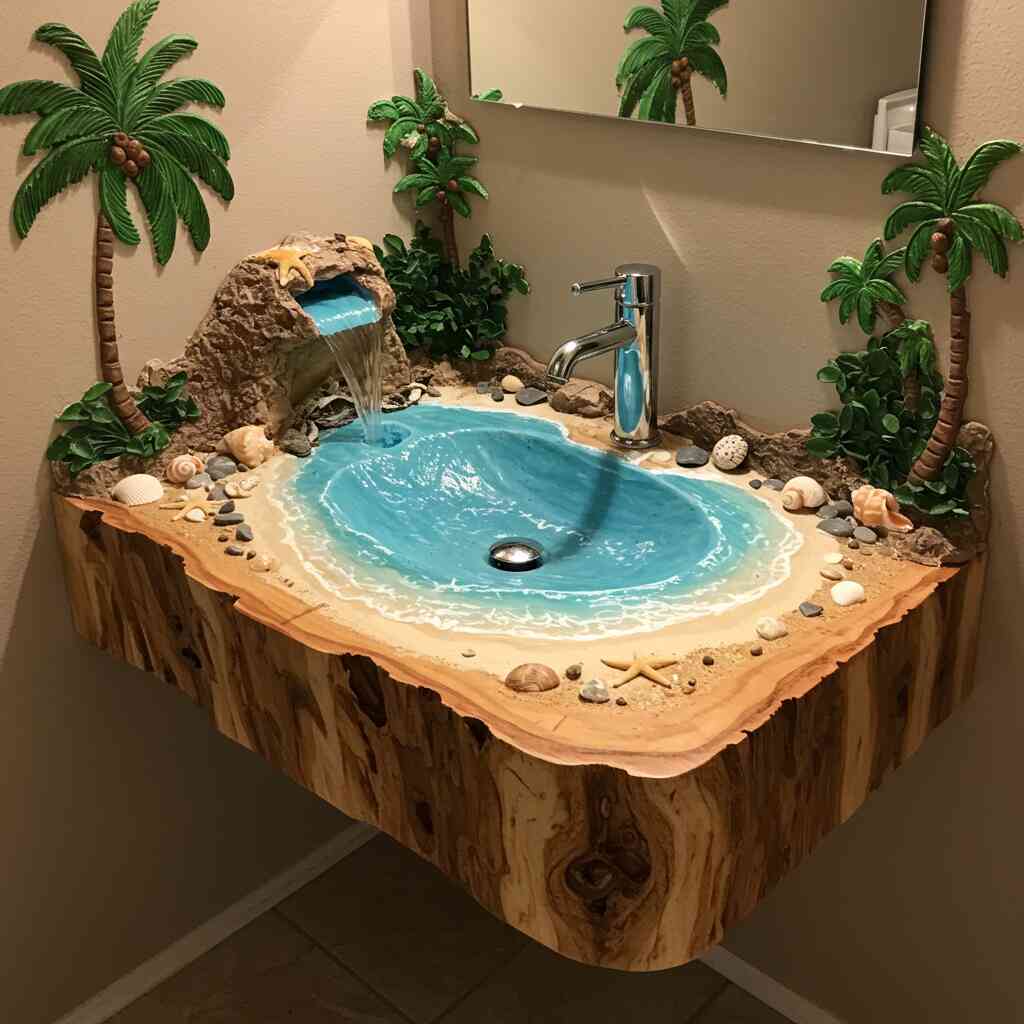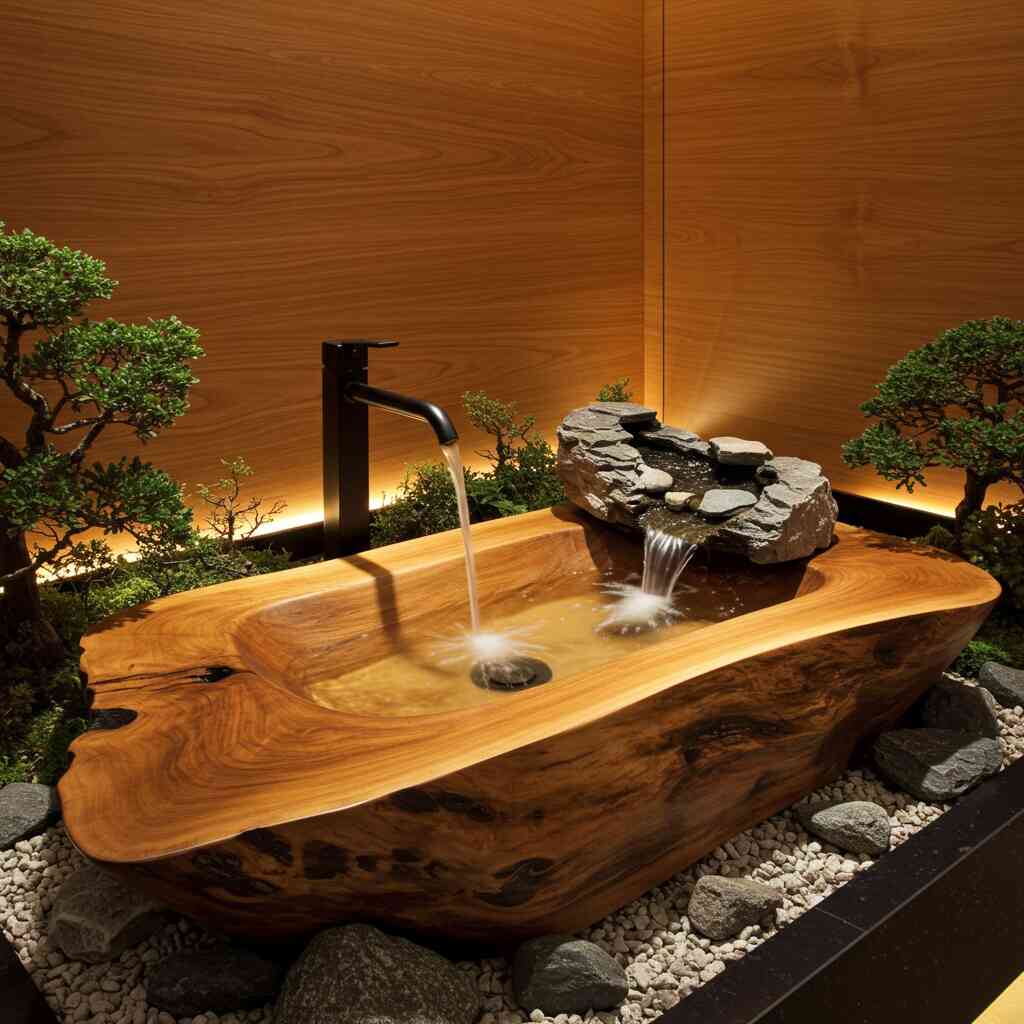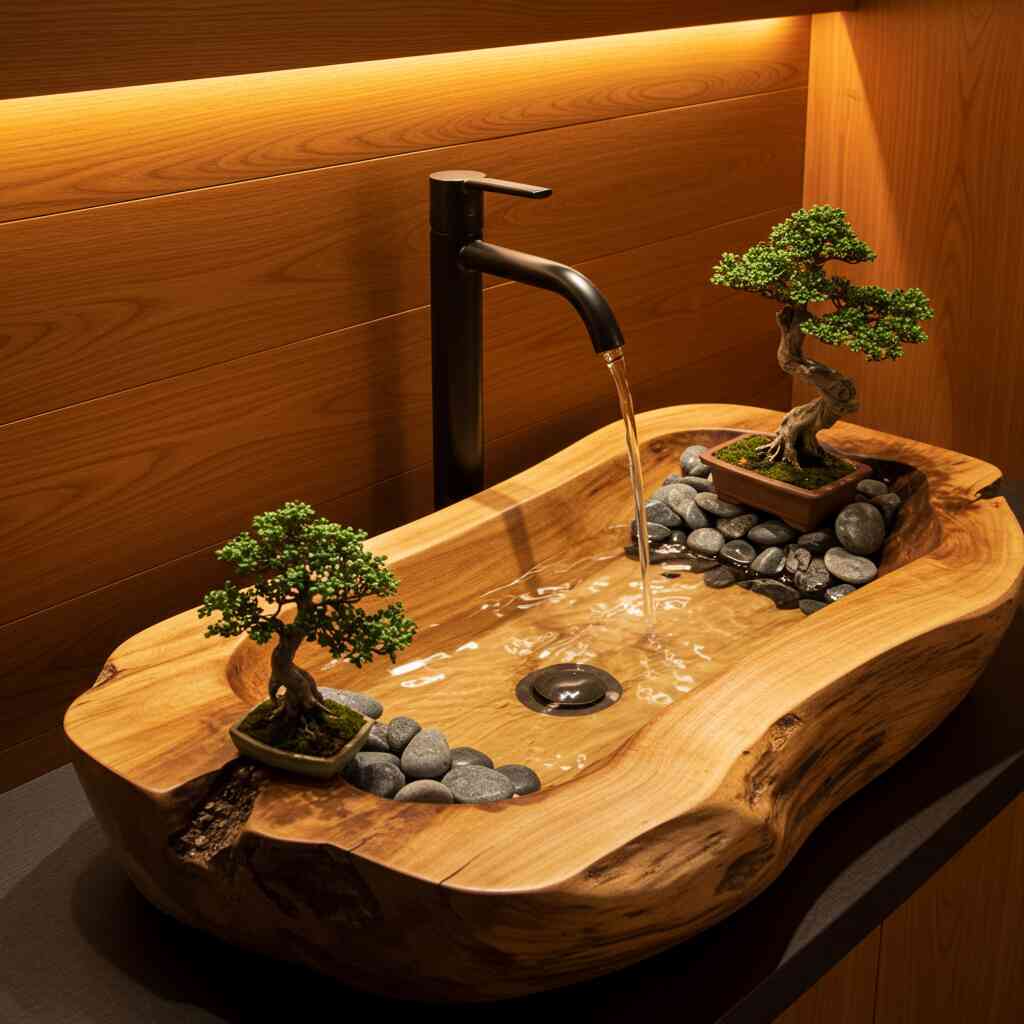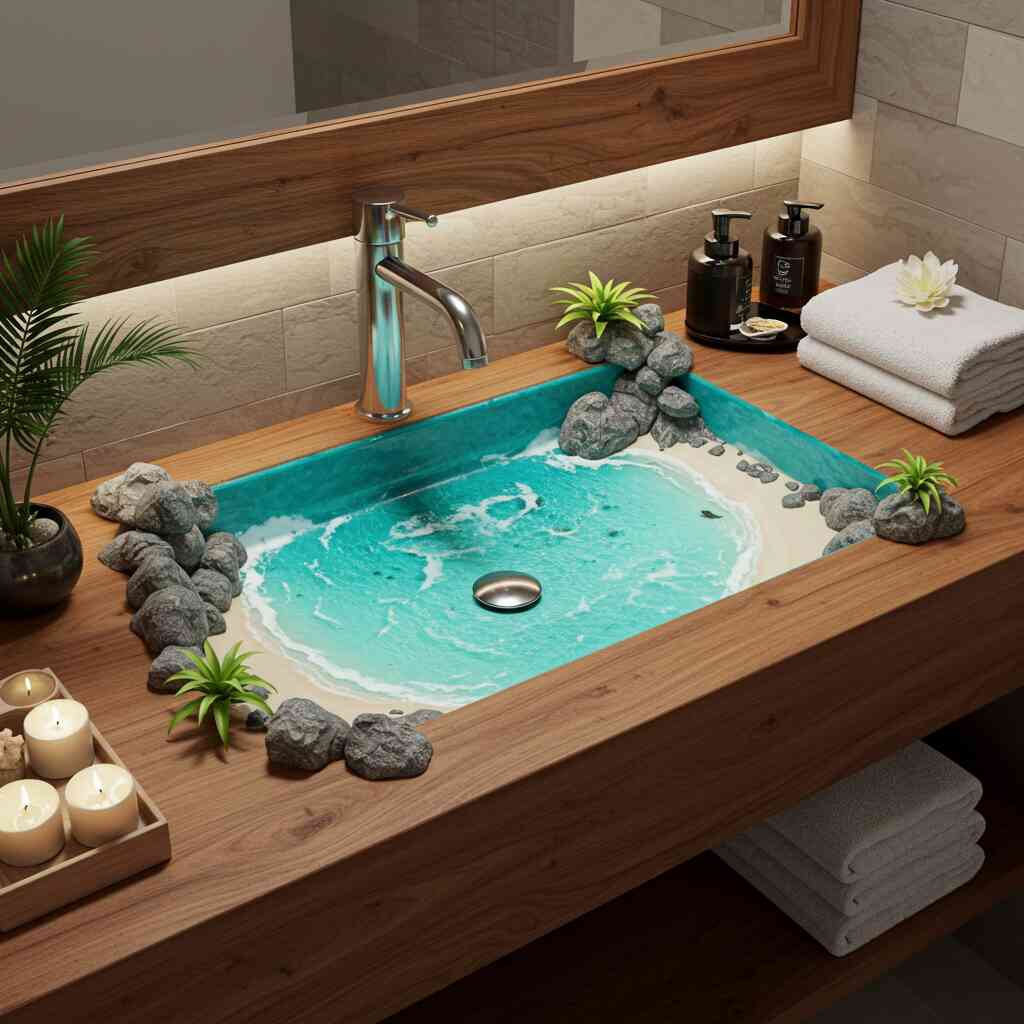In the evolving world of interior design, the bathroom has transformed from a purely functional space into a sanctuary of relaxation and personal expression. Among the many elements that contribute to this transformation, the sink stands out as both a focal point and a canvas for creativity. A nature themed sink can bring the serenity and organic beauty of the outdoors into your daily routine, creating a sense of calm and connection within your home.
Designing a nature-inspired bathroom doesn’t merely involve adding a few plants or earthy tones—it’s about crafting an environment where every detail reflects the essence of the natural world. The sink, often the centerpiece of the room, becomes a unique opportunity to express this theme through materials, textures, shapes, and even lighting. Whether you’re renovating your entire bathroom or simply updating one fixture, a nature-themed sink can serve as the heart of a transformative design concept.
This article explores the creative possibilities available when designing a nature-themed sink for your bathroom. From selecting raw, organic materials to incorporating botanical motifs and integrating sustainable practices, we’ll delve into how each element contributes to a cohesive and immersive experience. We will also examine how lighting, color palettes, and complementary accessories can enhance the overall effect of a nature-inspired sink area.
Whether you are drawn to rustic charm, minimalist elegance, or whimsical fantasy, there is a design approach that aligns with your vision. By thoughtfully curating each aspect of your sink’s design, you can create a space that not only serves its purpose but also nurtures your well-being. Let’s begin our journey by exploring the foundational aspects of a nature-themed sink, starting with the importance of natural materials and textures.

Part 1: Embracing Natural Materials and Textures
At the core of any nature-themed design lies the use of authentic, tactile materials that evoke the feel of the outdoors. When it comes to sinks, the choice of material plays a pivotal role in establishing the overall aesthetic and sensory experience. Unlike mass-produced porcelain or glossy ceramic fixtures, natural materials offer a depth of texture and character that resonates with the organic world.
Stone Sinks: Timeless Elegance Rooted in Nature
One of the most popular choices for a nature-themed sink is stone—whether it be granite, marble, limestone, or river rock. Each type of stone carries its own unique grain and imperfections, which contribute to a sense of authenticity and timelessness. Granite, known for its durability and rich veining, brings a bold presence to the bathroom, while marble offers a softer, more refined look. Limestone, with its subtle earthy tones and porous surface, adds a rustic touch that mimics the natural erosion found in outdoor landscapes.
Stone sinks can be carved into a variety of shapes—from sleek, modern basins to rugged, hand-hewn vessels that resemble natural rock formations. Some designs even incorporate embedded fossils or mineral deposits, further enhancing the connection to the earth. These sinks are often left unpolished or semi-polished to preserve their natural texture, offering a tactile experience that invites interaction.
Wood: Warmth and Organic Beauty
Wooden sinks may seem unconventional at first, but they have gained popularity among those seeking warmth and a truly organic feel. Typically made from teak, bamboo, or reclaimed hardwoods, these sinks are sealed with waterproof finishes to ensure longevity. The natural grain of the wood tells a story, with each knot and swirl reflecting the tree’s life history.
A wooden sink can be integrated into a countertop or stand alone as a vessel-style basin. When paired with stone or copper accents, it creates a harmonious blend of textures and colors reminiscent of forest floors and mountain streams. However, wood requires regular maintenance to prevent warping or mold growth, making it ideal for those who appreciate the living quality of natural materials.

Concrete: Industrial Meets Organic
Concrete may not immediately come to mind when thinking of a nature-themed sink, but when used creatively, it can evoke a sense of rawness and simplicity akin to natural rock formations. Custom concrete sinks allow for fluid, sculptural forms that mimic the irregularity of nature. They can be tinted with earthy pigments or textured to resemble bark, sandstone, or even coral reefs.
The appeal of concrete lies in its versatility and ability to age gracefully. Over time, the surface develops a patina that enhances its character, much like weathered stone or driftwood. This makes it a compelling choice for those who want their sink to evolve organically over the years.
Combining Textures for Depth and Interest
To elevate the nature theme further, consider combining different natural materials within the same sink design. A stone basin mounted on a wooden base, or a concrete sink with embedded pebbles or shells, can create visual interest and tactile contrast. These combinations reflect the diversity of textures found in nature—rough against smooth, hard against soft—and invite a multisensory experience in the bathroom.
Textures also extend beyond the sink itself. Rough-hewn stone countertops, linen towels, woven baskets, and hand-thrown ceramic soap dishes all contribute to the layered, grounded feeling of a nature-themed space. The key is to maintain balance—too many competing textures can overwhelm the senses, while too few can make the space feel flat.
By thoughtfully selecting and blending natural materials, you set the foundation for a sink that feels intrinsically connected to the earth. In the next section, we will explore how botanical and wildlife-inspired motifs can further enhance this connection, bringing the vitality and movement of nature indoors.

Part 2: Incorporating Botanical and Wildlife-Inspired Motifs
Beyond the physical qualities of natural materials, visual motifs drawn from the plant and animal kingdoms can deepen the nature theme of your sink area. These motifs breathe life into the space, transforming it from a static environment into one that feels dynamic and alive. Whether subtly hinted at through patterns or boldly expressed through sculptural elements, botanical and wildlife-inspired designs add layers of meaning and aesthetic richness.
Floral Patterns: Delicate and Inviting
Floral designs are perhaps the most intuitive way to introduce a nature theme into any interior space. In the context of a sink, floral motifs can appear in various forms—from etched glass mirrors to intricately carved wooden vanity drawers. Subtle floral engravings on stone or ceramic surfaces can suggest the presence of blooming gardens without overwhelming the space.
For those who prefer a more immersive experience, consider a backsplash or tile mural featuring native flowers or lush greenery. Hand-painted tiles depicting wildflowers, ivy, or ferns can transform the wall behind the sink into a living tapestry. Alternatively, a framed botanical print above the mirror or a small vase of fresh flowers beside the sink can reinforce the floral motif in a more transient but equally impactful way.
Leaf and Vine Accents: Flowing and Organic
Leaves and vines represent the flowing, interconnected nature of life in the wild. Their sinuous lines and varied shapes can be incorporated into the design of the sink itself or used as decorative embellishments around the vanity. For example, a carved wooden sink might feature vine-like handles or a leaf-shaped drain cover. Metal fixtures such as faucets or towel bars can be designed with twisted branch-like arms or adorned with tiny leaf-shaped knobs.
These motifs work particularly well in transitional spaces between indoor and outdoor environments, such as bathrooms with large windows or skylights. The interplay of real sunlight filtering through actual leaves outside and artificial leaf patterns inside creates a seamless continuity between nature and design.
Animal Silhouettes: Whimsy and Symbolism
While less common than botanical motifs, animal silhouettes can add a whimsical or symbolic dimension to a nature-themed sink. Birds, fish, frogs, and butterflies are popular choices due to their associations with water, air, and transformation. A faucet shaped like a bird’s neck pouring water into the basin or a mirror frame designed to resemble a school of fish swimming around its edges can become conversation pieces while reinforcing the theme.
Symbolically, animals can carry meanings that resonate personally with the homeowner. For instance, a frog motif might represent renewal and adaptability, while a butterfly could symbolize change and beauty emerging from stillness. These deeper connections make the design more meaningful and emotionally engaging.
Moss and Living Walls: Bringing Real Nature Indoors
For a truly immersive experience, some homeowners integrate live moss or vertical gardens into the sink area. Moss thrives in humid environments and can be grown in crevices of stone walls or within specially designed planter compartments near the sink. Its vibrant green color and velvety texture add a tactile and visual element that is both soothing and grounding.
Living walls—vertical installations of small plants—can be placed adjacent to the sink or above the mirror. These walls not only purify the air but also create a sense of being surrounded by a forest or jungle canopy. Careful consideration must be given to lighting and irrigation systems to ensure the plants thrive indoors, but the result is a stunningly organic backdrop for your nature-themed sink.
Artistic Interpretations: Abstract Representations of Nature
Not all nature-inspired designs need to be literal. Abstract interpretations using organic curves, wave-like patterns, or freeform shapes can convey the essence of nature without direct representation. These artistic approaches allow for greater flexibility in design while still maintaining a strong thematic link to the natural world.
Ceramic sinks with rippling surfaces, for instance, evoke the movement of water, while asymmetrical basins mimic the uneven forms of river stones. Even the placement of fixtures and accessories can follow a non-linear layout, echoing the unpredictable yet harmonious patterns found in nature.
By weaving together botanical and wildlife motifs—both literal and abstract—you infuse your sink area with the vitality of the natural world. In the final part of this article, we will explore how lighting, color schemes, and accessories can complete the nature-themed experience, ensuring that every element works in harmony to create a cohesive and tranquil environment.

Part 3: Enhancing the Atmosphere with Lighting, Color, and Accessories
Once the structural and decorative elements of the nature-themed sink are in place, the final touches—lighting, color palette, and accessories—bring everything together into a unified and immersive experience. These components play a crucial role in setting the mood and reinforcing the connection to the natural world, ensuring that the sink area feels like a peaceful retreat rather than just another functional fixture in the bathroom.
Natural Light: Harnessing the Power of the Sun
Natural light is one of the most effective ways to enhance a nature-themed sink area. If possible, position the sink near a window or skylight to allow sunlight to pour in throughout the day. Morning light can highlight the textures of stone or wood, while afternoon sun casts warm, golden hues that mimic the changing light in a forest clearing.
Sheer curtains or frosted glass can be used to diffuse harsh sunlight while preserving privacy. For added ambiance, consider installing a solar tube or light well if the bathroom lacks a traditional window. The interplay of light and shadow across natural materials creates a dynamic visual experience that changes with the time of day, deepening the connection to the rhythms of nature.
Artificial Lighting: Mimicking Natural Conditions
When natural light isn’t sufficient, carefully chosen artificial lighting can replicate its effects. Soft, warm-toned LED lights with adjustable brightness settings allow for customization depending on the desired atmosphere. Under-cabinet lighting can accentuate the texture of a stone countertop or highlight botanical details on a mirror frame.
Recessed lighting installed above or around the mirror provides even illumination for grooming tasks, while pendant lights or wall sconces with wooden or woven shades add a decorative touch. For a more dramatic effect, fiber-optic ceiling panels can simulate a starry night sky, turning the bathroom into a celestial escape after dark.
Earthy Color Palettes: Creating a Harmonious Environment
Color plays a significant role in shaping the emotional tone of a space. For a nature-themed sink, opt for a palette inspired by the outdoors—soft greens, warm browns, muted blues, and creamy whites. These colors mimic the hues of forests, beaches, mountains, and meadows, creating a soothing backdrop that enhances the natural elements already present.
Walls painted in sage green or sandy beige complement stone or wooden sinks beautifully. Accent walls featuring nature-inspired wallpaper—such as tree bark textures or cascading ivy—add depth without overpowering the space. Even smaller details like towels, rugs, and shower curtains in earth tones can unify the design and reinforce the theme.
Consider the psychological impact of color as well. Blues and greens are known to promote calmness and relaxation, making them ideal for a bathroom sanctuary. Browns and tans evoke stability and grounding, while white introduces a sense of cleanliness and purity—perfect for balancing darker, richer tones.
Natural Accessories: Completing the Scene
Accessories are the finishing touches that tie the nature theme together. Choose items made from organic materials—such as bamboo toothbrush holders, soap dishes carved from olive wood, or cotton bath mats with jute backing. Glass bottles filled with homemade soaps or essential oils add both functionality and fragrance, evoking the aromas of a forest after rain or a field of wildflowers.
Mirrors can be framed with driftwood or woven reeds to echo the textures of the natural world. Towel racks made from branches or repurposed twigs bring a rustic charm to the space. Even small potted plants—like aloe vera or spider plants—introduce living greenery that cleanses the air and adds vibrancy.
Storage solutions should also reflect the theme. Wicker baskets, clay jars, and linen pouches provide practical organization while maintaining the organic aesthetic. Avoid plastic or overly industrial materials that disrupt the flow of the nature-inspired design.
Water Sounds: Engaging the Senses
No nature-themed space would be complete without engaging the auditory senses. Consider installing a small tabletop fountain near the sink or incorporating a waterfall-style faucet that mimics the gentle sound of running water. These subtle sounds can mask unwanted noise and enhance relaxation, creating a spa-like atmosphere that encourages mindfulness and tranquility.
Additionally, ambient sound machines or smart speakers programmed with nature sounds—like birdsong, ocean waves, or rustling leaves—can be used to further immerse the user in a natural environment. These elements transform the act of washing hands or brushing teeth into a meditative ritual, connecting everyday routines with the rhythms of the earth.

Conclusion
Designing a nature-themed sink in your bathroom is more than a stylistic choice—it is an invitation to reconnect with the natural world in a deeply personal and intimate setting. Through thoughtful selection of materials, incorporation of botanical and wildlife motifs, and careful attention to lighting, color, and accessories, you can craft a space that transcends mere function and becomes a source of inspiration and peace.
Each element—from the rough-hewn texture of a stone basin to the delicate curve of a leaf-shaped faucet—contributes to a larger narrative of harmony between human habitation and the natural environment. By embracing the imperfections, textures, and organic forms found in nature, you create a space that feels alive, ever-changing, and uniquely attuned to the rhythms of the earth.
Ultimately, a nature-themed sink is not just about aesthetics; it is about cultivating a mindset of mindfulness, sustainability, and appreciation for the world beyond our walls. It reminds us that even in the most utilitarian corners of our homes, there is room for beauty, wonder, and a quiet communion with nature.